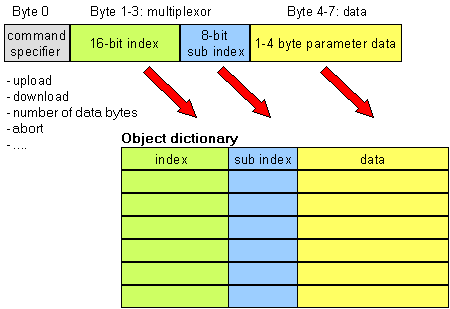Service Data Objects (SDO)
The parameters listed in the object directory are read and written by means of service data objects. These SDOs are Multiplexed Domains, i.e. data structures of any size that have a multiplexer (address). The multiplexer consists of a 16-bit index and an 8-bit sub-index that address the corresponding entries in the object directory.
The CANopen Bus Couplers are servers for the SDO, which means that at the request of a client (e.g. of the IPC or the PLC) they make data available (upload), or they receive data from the client (download). This involves a handshake between the client and the server.
When the size of the parameter to be transferred is not more than 4 bytes, a single handshake is sufficient (one telegram pair): For a download, the client sends the data together with its index and sub-index, and the server confirms reception. For an upload, the client requests the data by transmitting the index and sub-index of the desired parameter, and the server sends the parameter (including index and sub-index) in its answer telegram.
The same pair of identifiers is used for both upload and download. The telegrams, which are always 8 bytes long, encode the various services in the first data byte. All parameters with the exception of objects 1008h, 1009h and 100Ah (device name, hardware and software versions) are only at most 4 bytes long, so this description is restricted to transmission in expedited transfer.
Protocol
The structure of the SDO telegrams is described below.
Client -> Server, Upload Request
Client -> Server, Upload Response
Parameters whose data type is Unsigned8 are transmitted in byte D0, parameters whose type is Unsigned16 use D0 and D1.
The number of valid data bytes is coded as follows in the first CAN data byte (0x4x):
Client -> Server, Download Request
It is optionally possible to give the number of valid parameter data bytes in the first CAN data byte
This is, however, not generally necessary, since only the less significant data bytes up to the length of the object directory entry that is to be written are evaluated. A download of data up to 4 bytes in length can therefore always be achieved in BECKHOFF bus nodes with 22 h in the first CAN data byte.
Client -> Server, Download Response
Breakdown of Parameter Communication
Parameter communication is interrupted if it is faulty. The client or server send an SDO telegram with the following structure for this purpose:
List of SDO error codes (reason for abortion of the SDO transfer):
Further, manufacturer-specific error codes have been introduced for register communication (index 0x4500, 0x4501):
